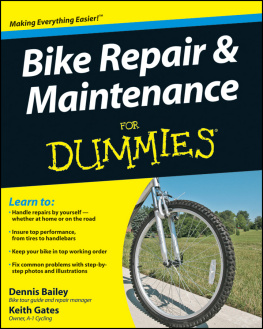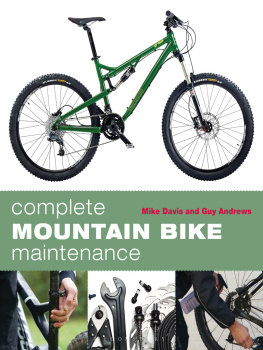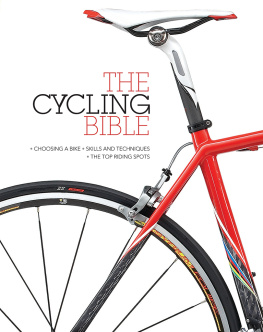
Whether you are an experienced racer or just starting out, knowing how to keep your bike in peak condition is essential to your enjoyment of cycling. Being able to recognise the early warning signs of mechanical trouble and what to do about them means less time and money wasted getting your bike fixed and more time in the saddle. Professional team bikes now cost in excess of 8,000 and, if you want the best, keeping a bike of this quality on the road is no easy task.
Whatever rider or mechanic level you are at, we hope that this clearly illustrated book with step-by-step photographs will help. Its fully up-to-date with the latest bikes and bike technology. In there are also some tips on what to look out for when buying a bike and some basic tool and workshop advice, should you need to start from scratch. Fixing a bike for yourself is hugely rewarding and its great to know that you can be miles from home and yet be able to fix your bike in the unlikely event of a mechanical failure.
This is a road bike similar to the ones professional riders use. A bike with top-of-the-range components and lightweight wheels will cost the same as a hatchback car, although it requires far more looking after, and replacement parts and servicing can cost a fair bit. However, a perfectly balanced bike like this one will ride superbly. The component groupsets are usually Shimano Dura-Ace, SRAM Red or Campagnolo Super Record and wheels by Zipp, Mavic and Lightweight are reassuringly expensive and very popular.
Road racing geometry is very aggressive and the position is quite extreme. Professional riders spend a long time in the saddle and are used to an aerodynamic position, so this will not be suited to a rider that only manages to ride a couple of times a week. Be realistic with your aspirations and consider a bike with a more Sportive approach. Many manufacturers now offer high-end road bikes with the same technology and componentry as the professionals bike, albeit with a more relaxed fit and usually a more comfortable ride.
Many of these frames are ideal for long days in the saddle and riding over rough terrain and poor road surfaces. The pro teams sometimes use these bikes for Paris-Roubaix and the Tour of Flanders where they race for many hours over vicious cobbles and poor roads.
CYCLO-CROSS
Every winter, the sport of cyclo-cross means hundreds of road riders pull out their neglected cross bikes and head off-road. Cross bikes make an excellent second bike, as they can be set up as a commuter or training bike for the rest of the year.
A strong, lightweight, well-built frame is far more important than excellent components once theyre covered in mud, function level is pretty academic. Wheels and tyres also play a considerable part in cyclo-cross success. Many manufacturers now have a cross bike in their range, such is the current popularity of this winter sport. Once, these bikes would have been made up from old touring bikes and junk parts now theyre state-of-the-art carbon frames and high-end component-equipped race machines. Many mountain bike technologies have drifted into cyclo-cross including disc brakes and tubeless tyres, but cyclo-cross requires skill and control.
The Union Cyclist International (UCI world cycling governing body) is very anxious to keep cyclo-cross pure and related to road bicycle riding as much as possible, so very often bikes that get too much like their mountain biking cousins are not allowed in sanctioned races. Cyclo-cross is a tough sport and teaches skill and technique that will help your road riding improve.
(See for more on cyclo-cross bikes.)
ENTRY-LEVEL RACING BIKE
An entry-level bike like this one will be mid-priced and perfect for your first few seasons of road riding, and even a race or two. Many of these bikes will have Compact Drive (see ), which is a good choice for beginners. Components-wise, look out for Shimano 105 or Campagnolo Veloce groupsets.
TOURING
Touring bikes are usually made from steel its not going to be the lightest bike on the market, but it will provide strength for carrying luggage and comfort for long rides. A long wheelbase and a steel fork are worth looking out for.
Some long-distance riders prefer a frame with slightly slacker seat and head tube angles, to provide a more comfortable ride. Often a custom-built bike is a good option so these characteristics are built into the bike. A custom fit is sometimes the best route for many of these riders, but there are several manufacturers now offering a more sedate road bike, perfect for all-day rides and challenge rides.
TRACK
Track bike geometry is generally tight and steep with short rake forks and a high bottom bracket (for pedal and banking clearance). Track bikes also have niche set-ups and types too sprinters are after power so they prefer stiff, over-built frames with steel handlebars and lower front ends; endurance riders are after aerodynamics and usually use road components; and track pursuit bikes resemble road TT bikes.
Fixed-wheel competition track bikes have one drive option (fixed), no brakes and one gear ratio. Fixed has the main advantage of maintaining momentum (one of the reasons its favoured by time-triallists and specialist hill-climbers). After riding fixed, your pedal action will become smoother (which is why track riders always have good pedal actions) and after thousands of kilometres youll begin to use more of the pedal stroke to get the power down.
Its known as souplesse from the French literally, a supple pedal action. Riding a fixed bike on the road can be a wonderful experience too, but only if the riding in your area is suitable and you remember that you cant stop pedalling... so riding fixed can be hazardous if youre not familiar with fixed gear riding (its best to go to the track to learn how) or the hardware youre using isnt up to the job. The climbing technique is also useful, as a single gear means you have to get up the hill in the only gear you have. It stops you getting lazy and using the gears, but it also teaches you how to squeeze every bit of advantage out of your technique the momentum gained on the downstroke can easily be transferred to the upstroke, thus allowing all the power in the stroke to be used, and allowing a good pull technique to the stroke.
(See for more on Track bikes.)
SPORTIVE
Its not all about racing. Each year, several thousand riders take part in challenge rides. These are often set out on one of the stages of the Grand Tours. You get to ride a stage of the Tour de France, known as the Etape, and some 10,000 participants are accepted each year with at least as many more being disappointed. Fancy being able to see what the professionals have to do for a living? You will not be disappointed its a very humbling experience. The bikes are often geared according to mountainous terrain and the fit is more relaxed and comfortable than a pure racing bike.
Next page

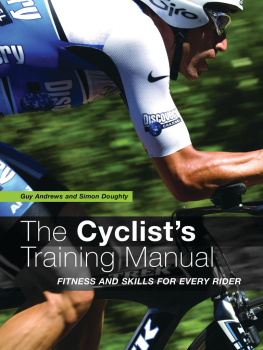
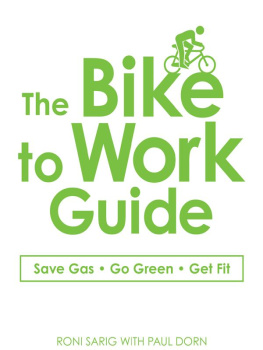


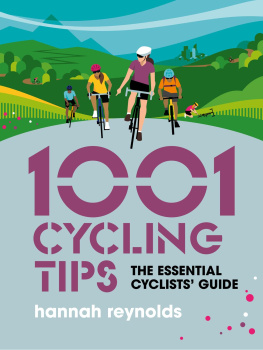
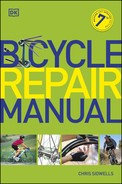
![Shanks - Essential bicycle maintenance & repair: [step-by-step instructions to maintain and repair your road bike]](/uploads/posts/book/235248/thumbs/shanks-essential-bicycle-maintenance-repair.jpg)
